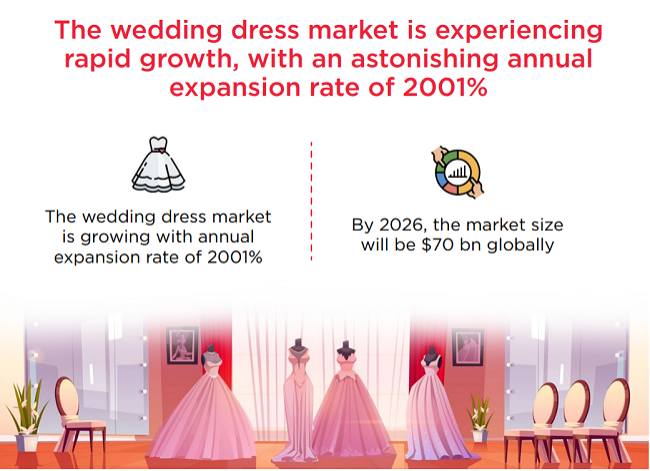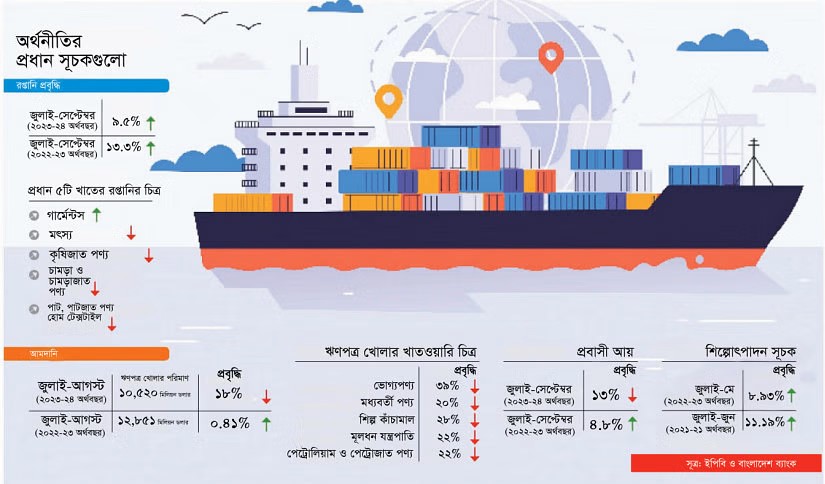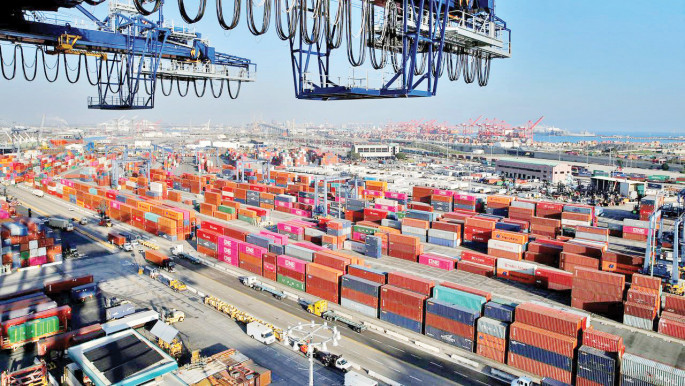ধীর গতির অর্থনৈতিক প্রবৃদ্ধি নিয়ে ২০২২-২৩ অর্থবছর শেষ করেছিল বাংলাদেশ। চলতি অর্থবছরেও একই প্রবণতা অব্যাহত আছে।
ধীর গতির অর্থনৈতিক প্রবৃদ্ধি নিয়ে ২০২২-২৩ অর্থবছর শেষ করেছিল বাংলাদেশ। চলতি অর্থবছরেও একই প্রবণতা অব্যাহত আছে। দেশের অর্থনীতির অন্তত তিনটি প্রধান সূচক- রপ্তানি, প্রবাসী আয় ও আমদানির তথ্যে সেই দৃশ্যে ফুটে উঠেছে।
চলতি অর্থবছরের প্রথম প্রান্তিকে দেশের বৈদেশিক মুদ্রার প্রধান উৎস রপ্তানি আয়ের প্রবৃদ্ধি কমে ৯ দশমিক ৫ শতাংশ হয়েছে। গত অর্থবছরের প্রথম তিন মাসে যা ছিল ১৩ দশমিক ৩ শতাংশ।
বৈদেশিক মুদ্রার আরেকটি উৎস রেমিট্যান্স কমেছে ১৩ শতাংশ, যদিও গত অর্থবছরে রেকর্ড ১১ লাখ ৩৭ হাজার শ্রমিক বিদেশে পাড়ি জমান।
অন্যদিকে আমদানির মাধ্যমে অন্য দেশ থেকে শিল্প কাঁচামাল, মধ্যবর্তী পণ্য ও প্রধান যন্ত্রপাতি আনা হয়, এই খাতও সমস্যার সম্মুখীন হয়েছে।
চলতি বছরের জুলাই-আগস্টে ঋণপত্র খোলার হার আগের বছরের চেয়ে ১৮ শতাংশ এবং নিষ্পত্তি ২২ শতাংশ কমেছে। ডলারের ঘাটতি ও রিজার্ভ ধরে রাখতে মরিয়া কেন্দ্রীয় ব্যাংকের নীতির কারণে ২০২২-২৩ অর্থবছরে এটি ১৫ শতাংশ কমেছিল।
এটি শিল্প উৎপাদন ও উদ্যোক্তাদের নতুন বিনিয়োগের গতিকে ধীর করে দিয়েছে, যা অনাকাঙ্ক্ষিত।
বাংলাদেশ পরিসংখ্যান ব্যুরোর তথ্য অনুযায়ী, শিল্প উৎপাদনের সাধারণ সূচকে (মাঝারি ও বৃহৎ উৎপাদন) দেখা গেছে, ২০২২-২৩ অর্থবছরের মে মাস পর্যন্ত উৎপাদন আগের বছরের তুলনায় ৮ দশমিক ৯৩ শতাংশ বৃদ্ধি পেয়েছে। তবে, ২০২১-২২ অর্থবছরে কারখানার উৎপাদন বেড়েছিল ১১ দশমিক ১৯ শতাংশ।
সামগ্রিকভাবে, স্বল্পমেয়াদে বর্তমান অর্থনৈতিক দুর্দশা থেকে পুনরুদ্ধারের সম্ভাবনা অনেকটা অসম্ভব বলে মনে হচ্ছে। কারণ উচ্চ মূল্যস্ফীতি, বৈদেশিক মুদ্রা বাজারে অস্থিরতা ও রাশিয়া-ইউক্রেন যুদ্ধের মতো সংকটের খুব শিগগির সমাধানের কোনো লক্ষণ দেখা যাচ্ছে না।
এ ছাড়া, আগামী বছরের জানুয়ারিতে অনুষ্ঠেয় সাধারণ নির্বাচনকে কেন্দ্র করে ক্রমবর্ধমান রাজনৈতিক উত্তেজনা এই অনিশ্চয়তাকে আরও বাড়িয়ে তুলেছে।
ইনস্টিটিউট ফর ইনক্লুসিভ ফাইন্যান্স অ্যান্ড ডেভেলপমেন্টের নির্বাহী পরিচালক মোস্তফা কে মুজেরি বলেন, ‘রাজনৈতিক অনিশ্চয়তার মাত্রা বেশ বেশি। এই অব্যাহত অনিশ্চয়তার মধ্যে অর্থনীতি আরও ধীর হতে পারে এবং নিম্নমুখী প্রবণতা আরও গভীর হতে পারে। তার মানে কর্মসংস্থানের সুযোগ কমবে এবং আয় কমবে। সুতরাং, জনগণের দুর্ভোগ আরও বাড়বে।’
এমনিতেই রেকর্ড মূল্যস্ফীতির কারণে এক বছরেরও বেশি সময় ধরে বাংলাদেশের মানুষ সংকটের মধ্যে আছে।
বর্তমান পরিস্থিতির জন্য নীতিনির্ধারণী পর্যায়ে বাহ্যিক কারণগুলোকে দোষারোপ করার প্রবণতা থাকলেও কেন্দ্রীয় ব্যাংকের সাবেক এই প্রধান অর্থনীতিবিদ বলছেন, যুদ্ধের কারণে সৃষ্ট বৈশ্বিক সংকটকে দোষারোপ করে কোনো লাভ নেই। প্রতিবেশী ভারত ও শ্রীলঙ্কাসহ দক্ষিণ এশিয়ার দেশগুলো মুদ্রাস্ফীতির হার কমিয়েছে। শুধু তাই নয় চলমান সংকটের মধ্যে তারা অর্থনীতিকে আরও ভালোভাবে পরিচালনা করেছে।
তিনি বলেন, ‘আমাদের অভ্যন্তরীণ নীতির মধ্যে সমস্যা আছে। আমরা মূল্যস্ফীতি নিয়ন্ত্রণ করতে পারিনি। আমাদের বেশিরভাগ সমস্যার জন্য অভ্যন্তরীণ নীতিগত ব্যর্থতা দায়ী।’
এর মধ্যে বিপুল সংখ্যক মানুষ চাকরির জন্য বিদেশে যাওয়ার পর প্রবাসী আয় বা রেমিট্যান্স বাড়ার কথা ছিল। তবে, ব্যাংক ও অন্যান্য বৈধ মাধ্যমে মানি ট্রান্সফারে প্রদত্ত ডলারের হার এবং অনানু্ষ্ঠানিক চ্যানেলের মধ্যে একটি বড় ব্যবধান থেকে গেছে। এটি প্রবাসীদের কাছ থেকে বেশি রেমিট্যান্স পেতে অন্যতম বাধা।
অনানু্ষ্ঠানিক চ্যানেলের সঙ্গে ডলার প্রতি ৮ টাকা পর্যন্ত ব্যবধান থাকে, যা মূলত দরিদ্র অভিবাসী শ্রমিকদের পরিবার ও আত্মীয়স্বজনদের কাছে অর্থ পাঠানোর ক্ষেত্রে হুন্ডি অপারেটর বা অবৈধ চ্যানেলের দিকে প্রলুব্ধ করছে।
বাজার-ভিত্তিক বিনিময় হার এই পার্থক্য কমাতে পারে, অথচ বিশেষজ্ঞরা বারবার সুপারিশ করলেও এটি এখনো কার্যকর হয়নি।
পলিসি রিসার্চ ইনস্টিটিউট অব বাংলাদেশের ভাইস চেয়ারম্যান সাদিক আহমেদ মনে করেন, তিন মাসের তথ্য-উপাত্ত থেকে বিস্তৃত অর্থনৈতিক প্রভাব নিয়ে মন্তব্য করা কঠিন।
তবে তিনি মন্তব্য করেন, ‘প্রথম তিন মাসে রপ্তানি ও আমদানি প্রবৃদ্ধির মন্দা ২০২০-২৩ অর্থবছরের সঙ্গে সামঞ্জস্যপূর্ণ। এর মানে হলো অর্থনীতিকে পুনরুজ্জীবিত করতে স্থিতিশীল ব্যবস্থা ও কাঠামোগত সংস্কারের প্রয়োজন আছে।’
বিশ্বব্যাংকের দক্ষিণ এশিয়া অঞ্চলের প্রধান অর্থনীতিবিদসহ বিভিন্ন পদে দায়িত্ব পালন করা সাদিক আহমেদ বলেন, ‘রপ্তানি মন্দা তৈরি পোশাক খাতের বাইরের পণ্য রপ্তানি বৃদ্ধিতে অব্যাহত সক্ষমতার অভাবের প্রতিফলন।’
ঢাকা বিশ্ববিদ্যালয়ের অর্থনীতি বিভাগের সহযোগী অধ্যাপক ড. দীন ইসলাম বলেন, ‘বাজার সংশ্লিষ্টদের অনেকেই মনে করেন- যেহেতু বিনিময় হার কৃত্রিমভাবে কম রাখা হয়েছে, তাই কেন্দ্রীয় ব্যাংক শেষ পর্যন্ত তা সমন্বয় করতে বাধ্য হবে। এর ফলে, বৈদেশিক মুদ্রার সরবরাহ কমছে, কারণ অনেকে বৈদেশিক মুদ্রা ধরে রাখতে পছন্দ করে।’
তিনি বলেন, নির্বাচনের আগে মূলধন বহির্গমন ও রেমিট্যান্স পাঠাতে অবৈধ বা অনানুষ্ঠানিক চ্যানেল ব্যবহারসহ অন্যান্য প্রচলিত কারণ রেমিট্যান্স প্রবাহে প্রভাব ফেলেছে।
দীর্ঘদিন ধরে বাংলাদেশ নেতিবাচক বাণিজ্য ভারসাম্যের সঙ্গে লড়াই করেছে, কারণ আমাদের আমদানি বিল পরিশোধ রপ্তানি আয়ের চেয়ে বেশি। এমন পরিস্থিতিতে, অভিবাসী শ্রমিকদের পাঠানো রেমিট্যান্স দেশের অর্থনীতির জন্য গুরুত্বপূর্ণ ঢাল হিসেবে কাজ করেছে।
তিনি বলেন, ‘দুর্ভাগ্যবশত সাম্প্রতিক মাসে রেমিট্যান্স উদ্বেগজনকভাবে কমেছে। যা অবশ্যই উদ্বেগের বিষয়।’
গত দেড় বছরে মার্কিন ডলারের বিপরীতে টাকার মূল্য প্রায় ২৮ শতাংশ কমেছে।
তার মতে, সরকার বা কেন্দ্রীয় ব্যাংক যদি বিনিময় হার নিয়ন্ত্রণ করতে চায়, তাহলে আমদানির ওপর বিধিনিষেধ আরোপ করতে হবে। উভয় ক্ষেত্রেই মূল্যস্ফীতি বৃদ্ধি পাবে, জনগণের ক্রয় ক্ষমতা কমবে এবং অর্থনৈতিক কার্যক্রম কমবে। ফলে, অর্থনৈতিক প্রবৃদ্ধি ধীর হতে পারে।
তিনি বলেন, ‘সাম্প্রতিক রেমিট্যান্সের প্রবাহ কমার জন্য নির্বাচনকে ঘিরে বিরাজমান অনিশ্চয়তাকেও দায়ী করা যেতে পারে। এই অনিশ্চয়তা দেশের ভবিষ্যত অর্থনৈতিক সম্ভাবনা নিয়ে জনগণের প্রত্যাশার ওপরও প্রভাব ফেলছে।’
একজন উদ্যোক্তা বলছেন, শিল্প ব্যবহারের পণ্য আমদানি করতেও ব্যবসায়ীরা অসুবিধার সম্মুখীন হচ্ছেন।
তিনি বলেন, ‘গ্যাসের দাম বেশি ও নিরবচ্ছিন্ন বিদ্যুৎ সরবরাহের কোনো নিশ্চয়তা নেই। মানুষ রাজনৈতিক অনিশ্চয়তার চেয়ে তাদের দৈনন্দিন কাজ নিয়ে বেশি উদ্বিগ্ন।’
এই উদ্যোক্তা রাজস্ব কর্তৃপক্ষ ও বাংলাদেশ ব্যাংকের প্রতি ব্যবসাবান্ধব মনোভাব দেখানোর আহ্বান জানান।
কী করা যেতে পারে?
সাদিক আহমেদের মতে, রপ্তানি প্রবৃদ্ধি দুই অঙ্কে ফিরিয়ে আনতে পোশাক পণ্যের বাইরে অন্যান্য পণ্য রপ্তানির দিকে মনোনিবেশ করতে হবে। দেশের রপ্তানি বহুমুখী করা প্রয়োজন।
তিনি বলেন, সাম্প্রতিক সময়ে বিশেষ করে ২০২২-২৩ অর্থবছরে কার্যকর বিনিময় হারের অতিরিক্ত মূল্যায়নের কিছু সংশোধন হয়েছে। কিন্তু বাণিজ্য সুরক্ষা অবিচ্ছিন্নভাবে অব্যাহত আছে। এজন্য বাজারভিত্তিক বিনিময় হারের পাশাপাশি আমদানি শুল্কসহ অন্যান্য প্যারা-ট্যারিফ যেমন সম্পূরক শুল্ক এবং নিয়ন্ত্রক শুল্ক কমানো প্রয়োজন। বাণিজ্য সরবরাহ ব্যবস্থার উন্নতিও প্রয়োজন হবে।’
আমদানিকারকদের প্রয়োজনীয় কাঁচামাল ও উৎপাদনে ব্যবহৃত পণ্য কেনার সুযোগ দিতে বিনিময় হার ও আমদানি বিধিনিষেধ তুলে নেওয়ার পরামর্শ দেন এই অর্থনীতিবিদ।
তবে দীন ইসলাম স্বল্পমেয়াদে বর্তমান দুর্দশার কোনো সমাধান দেখছেন না।
তিনি বলেন, অর্থনীতি নিয়ে উচ্চাশা রাজনৈতিক স্থিতিশীলতার সঙ্গে জড়িত। তবুও, কিছু বাজারমুখী নীতি গ্রহণ করা হলে পরিস্থিতির উন্নতি হতে পারে। প্রথমত, কেন্দ্রীয় ব্যাংকের একটি নমনীয় বিনিময় হার ব্যবস্থা গ্রহণ করা উচিত। দ্বিতীয়ত, আন্ডার বা ওভার ইনভয়েসিংয়ের মাধ্যমে কার্যকরভাবে বৈদেশিক মুদ্রার বহিঃপ্রবাহ কমাতে শুল্ক কার্যক্রম জোরদারের প্রয়োজন আছে।
তৃতীয়ত, গার্মেন্টস শিল্প বৈদেশিক মুদ্রা অর্জনের ক্ষেত্রে প্রভাবশালী হলেও, এটি আমদানি করা উপকরণের ওপর নির্ভরশীল। এটি মোকাবিলায় রপ্তানি বহুমুখীকরণ ও কম আমদানির খাতগুলোকে উৎসাহিত করার প্রচেষ্টা শুরু করতে হবে।






















